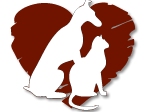Library
-
Plotts love hunting and family, arguably in that order. They love to follow a trail to its end, but at the end of the hunt, they are glad to celebrate with their favorite people.
-
Pneumothorax is an accumulation of air outside the lungs, but inside the chest wall. The air outside the lung prevents the lungs from inflating normally, and can lead to lung collapse. There are several variations of pneumothorax.
-
Pneumothorax is an accumulation of air outside the lungs, but inside the chest wall. The air outside the lung prevents the lungs from inflating normally, and can lead to lung collapse. There are several variations of pneumothorax.
-
Pododermatitis is a term used to describe inflammation of the feet or paws. It can be caused by many disorders including infections, allergies, hormonal disorders, immune-mediated diseases, tumors or cancers. Diagnostic testing is discussed. Effective treatment must be directed toward the underlying cause.
-
Pointers are warm, loving dogs capable of giving members of their family great affection. They are usually overflowing with nervous energy and ready to hunt at the drop of a leash.
-
The shaggy Polish Lowland Sheepdog may look like an overgrown stuffed animal, but he is a serious worker who needs a job to be fulfilled. Active people who can include a dog in their everyday adventures find the PON - that is short for Polski Owczarek Nizinny, the name of the breed throughout most of the world - is an energetic and fun-loving companion.
-
Polycystic Kidney Disease (PKD) is an inherited condition that causes multiple cysts (fluid pockets) in the kidneys. Persian cats and breeds with Persian bloodlines are most commonly affected. The clinical signs, diagnosis, genetic testing, and treatment options are explained in this handout.
-
Polycystic kidney disease (PKD) is an inherited kidney disease that is common in cats, but uncommon in dogs. Dogs with polycystic kidney disease develop multiple fluid-filled cysts within the kidney, with the number and size of these cysts increasing with age. As the kidney cysts displace larger amounts of functioning kidney tissue, the dog begins to show signs of chronic kidney disease. There is no specific treatment for polycystic kidney disease; treatment is centered on alleviating the signs of chronic kidney disease.
-
Polycythemia vera is a rare disease of dogs and cats in which too many red blood cells are produced by the bone marrow. The blood becomes thick and has difficulty moving through the small blood vessels. Your pet may feel tired, sluggish, and weak. Polycythemia is a potentially fatal disease, but if discovered early enough, treatment may be possible. If left untreated, polycythemia vera can affect the heart.
-
Polyethylene glycol is an off-label laxative used to treat constipation and empty the colon in preparation for procedures such as colonoscopy. The most common side effects are diarrhea, flatulence, and abdominal cramping. Do not use it in pets that are allergic to it or in pets with an intestinal blockage/obstruction.

